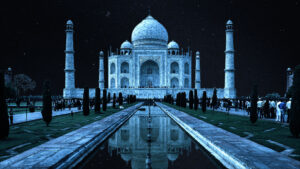Fatehpur Sikri Famous For: Nestled amidst the arid landscapes of northern India, Fatehpur Sikri stands as a resplendent testament to the artistic, architectural, and cultural marvels of the Mughal Empire. Renowned for its stunning fusion of Indo-Islamic architectural styles, this historical city exudes an air of grandeur that captivates the imagination of travelers and historians alike. Let’s delve into the captivating narrative of what makes Fatehpur Sikri famous for its exceptional heritage.
A Glimpse of History
Fatehpur Sikri, meaning “City of Victory,” was established by Emperor Akbar in the late 16th century. It was envisioned as the imperial capital, a place where the confluence of various cultures and religions could flourish harmoniously. This city was not just a symbol of power, but also a testament to Akbar’s inclusive ideologies and his aspiration to create a utopian city. The historic significance of Fatehpur Sikri is enshrined in its architectural magnificence and the tales it continues to whisper from its sandstone walls.
Architectural Extravaganza
The architectural brilliance of Fatehpur Sikri lies in its synthesis of diverse architectural styles. Indo-Islamic architecture, a harmonious blend of Persian, Central Asian, and Indian elements, is showcased in every facet of the city. The Buland Darwaza, a colossal gateway leading to the Jama Masjid, stands tall as a prime example of this architectural amalgamation. Carved intricately with Quranic inscriptions and adorned with ornate geometrical designs, the Buland Darwaza is a majestic entrance that commands attention.
As you walk through the expansive courtyards and imposing structures, you encounter the Diwan-i-Khas, the Hall of Private Audience. Here, Akbar’s intellectual pursuits converged with discussions on matters of state, surrounded by elegant columns and a central platform where the emperor held court. The elegant structure exemplifies the fine balance between aesthetics and functionality.
The Spiritual Haven
Fatehpur Sikri is also renowned for its spiritual significance. The Jama Masjid, an awe-inspiring mosque within the city, is an epitome of grace and symmetry. The white marble mihrab (prayer niche) adorned with delicate floral patterns is a sight to behold. The mosque’s serene ambiance invites visitors to reflect and find solace amidst its sacred walls.
Adjacent to the mosque is the Tomb of Sheikh Salim Chishti, a revered Sufi saint. The intricately carved marble lattice screens and exquisite marble tomb exude an aura of reverence. Pilgrims from diverse backgrounds seek blessings here, reaffirming the city’s ethos of inclusivity.
Pinnacle of Artistry
Fatehpur Sikri flourished as a center of artistry during the Mughal era. The Panch Mahal, a five-story architectural marvel resembling a mesmeric palace of winds, stands as a testament to the artistic finesse of that era. Each level diminishes in size, portraying an intriguing play of light and shadow while providing respite from the heat.
Artisans showcased their mastery through the Jodha Bai Palace, a blend of Rajput and Mughal architectural styles. The palace’s distinctiveness lies in its chhatri-topped columns, spacious courtyards, and intricately designed facades. This architectural gem, named after Akbar’s Rajput wife, transports visitors to a bygone era.
The Fatehpur Sikri Fortunes
Fatehpur Sikri is not merely a relic of the past; it is a living testament to history’s resonance. Its recognition as a UNESCO World Heritage Site underscores its global significance. The city’s architectural finesse, cultural inclusivity, and historical importance continue to be a source of inspiration for architects, historians, and enthusiasts.
The city’s fame also resides in the vivid narratives it holds. From the anecdotes of Birbal’s wit echoing in the Diwan-i-Khas to the lasting impact of Akbar’s administrative acumen, every cobblestone and wall painting reverberates with stories of a bygone era. These stories are woven into the very fabric of Fatehpur Sikri.
Legacy for the Future
As we traverse the timeless corridors of Fatehpur Sikri, it becomes evident that the city’s fame is not merely confined to its historical context. It transcends time, serving as a canvas that intertwines architecture, culture, and ideology. The city’s layout, its structures, and even the smallest ornamental details tell stories of an empire that sought to create a harmonious blend of diverse influences.
In a world where architectural heritage is often overshadowed by modernity, Fatehpur Sikri stands tall as a reminder of the need to preserve and celebrate our past. Its recognition as a symbol of cultural amalgamation and artistic brilliance underscores the importance of safeguarding such treasures for future generations.
Book Your Journey Today
Don’t miss the opportunity to explore the architectural wonders and historical treasures of Agra and Fatehpur Sikri. Embark on this 2-day expedition with The Imperial Tours and let the stories of emperors, love, spirituality, and architectural brilliance weave an indelible tapestry of memories. Book your journey today and let us be your companions in this unforgettable exploration of India’s glorious past.
Conclusion
Fatehpur Sikri Famous For: In the heart of India’s historical landscape, Fatehpur Sikri remains an alluring destination that beckons explorers, historians, and seekers of beauty alike. Its fusion of architectural styles, its spiritual sanctity, and the tales it silently narrates contribute to its enduring fame. This living testament to a bygone era invites us to pause, reflect, and marvel at the rich tapestry of human ingenuity and cultural convergence. As we wander through its sandstone corridors and stand before its regal gates, we are reminded that Fatehpur Sikri is not just a place frozen in time; it is a vibrant chronicle that continues to resonate with the pulse of history.
FAQ:
Fatehpur Sikri earned this moniker due to its sudden abandonment in the 16th century, attributed to water scarcity and shifting political interests, leaving its once vibrant streets eerily deserted.
Absolutely. Its awe-inspiring Indo-Islamic architecture, historical significance, and cultural richness make it a must-see UNESCO World Heritage Site that offers a captivating journey through history.
The centerpiece monument in Fatehpur Sikri is the Buland Darwaza, an imposing gateway that symbolizes victory. It showcases exquisite Indo-Islamic architecture and stands as a remarkable historical and architectural marvel.
Useful Links:
Golden Triangle India Tour Packages
Golden Triangle Tour with Udaipur from Delhi








